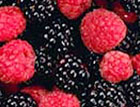Gardener's tips for this week
What to do in the garden in late October


Plant more raspberries
Raspberry canes have a productive life of eight or nine years, so if you plant new ones before the old ones dwindle, you will achieve continuity. If your old plants are healthy but not growing many new canes, now is the time to propagate from them to start a new row preferably not too close to the old ones. Pick out the strongest of the new canes, and, with a sharp spade, cut halfway down between the new growth and the old and try to lift away the new one with as much soil and root as possible. Raspberries are shallow-rooted plants, so replant at the same depth; they’ll appreciate a trench enriched with lots of organic compost to enrich them and to retain moisture. Cut the new canes back to 18in and don’t let them fruit next year.
Re-tie trained fruit trees
After a season’s use, replace the twine holding your trained fruit trees, even if it still looks fine. Winter’s winds will find out the weakest threads, and you risk damage to trees that have taken years to train. When tying the twine to galvanised wire strung between vine eyes, twist the twine a couple of times around the wire before retying the branch it’ll help to stop the twine slipping along the wire. We find that, on soft-lime-mortar walls, twine tied to galvanised nails is just as easy a way to train the branches; if the mortar is very soft, large fencing staples will hold even better.
Jerusalem artichokes
People either love them or hate them, but Jerusalem artichokes are a useful winter vegetable roasted or in soups. When the tall stalks and their leaves begin to turn yellow, cut them all down to protect the plant from wind damage; the tubers can be dug up when they’re needed. It’s an invasive plant, difficult to get rid of, and we’ve found the best way is to treat it like a potato. In early March, dig and select as many tubers as you need and put them out in a row 1ft apart on the surface of your prepared ground. Now draw the earth up and over the tubers, as if you were hilling potatoes. This produces tubers of excellent size, makes the digging easier and prevents the overgrown muddle usually experienced with artichokes. Try growing a smooth-skinned variety, such as Fuseau.
Tidy herbaceous plants
Sign up for the Country Life Newsletter
Exquisite houses, the beauty of Nature, and how to get the most from your life, straight to your inbox.
Ground conditions are usually drier now than in the New Year, so go ahead with the selective cutting down and tidying up of your herbaceous plants. If you prefer to leave the seed heads of your plants after their summer flowering, the different shapes and shades of brown will often still look attractive through the winter, but bear in mind that they can turn into a jumbled mess if there’s heavy snow. Most perennials will continue to be very vigorous if you divide them every few years as each grows and shoots in a different way, it’s a help to know exactly how your individual plants grow. Don’t split the clumps too small before replanting them; always add some leaf mould or compost to the soil when you put them in.
Philip Maddison is head gardener at Harrington Hall, Lincolnshire (www.harringtonhallgardens.co.uk)
Country Life is unlike any other magazine: the only glossy weekly on the newsstand and the only magazine that has been guest-edited by HRH The King not once, but twice. It is a celebration of modern rural life and all its diverse joys and pleasures — that was first published in Queen Victoria's Diamond Jubilee year. Our eclectic mixture of witty and informative content — from the most up-to-date property news and commentary and a coveted glimpse inside some of the UK's best houses and gardens, to gardening, the arts and interior design, written by experts in their field — still cannot be found in print or online, anywhere else.
-
 Burberry, Jess Wheeler and The Courtauld: Everything you need to know about London Craft Week 2025
Burberry, Jess Wheeler and The Courtauld: Everything you need to know about London Craft Week 2025With more than 400 exhibits and events dotted around the capital, and everything from dollshouse's to tutu making, there is something for everyone at the festival, which runs from May 12-18.
By Lotte Brundle
-
 Everything you need to know about private jet travel and 10 rules to fly by
Everything you need to know about private jet travel and 10 rules to fly byDespite the monetary and environmental cost, the UK can now claim to be the private jet capital of Europe.
By Simon Mills